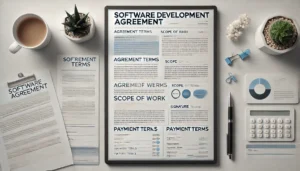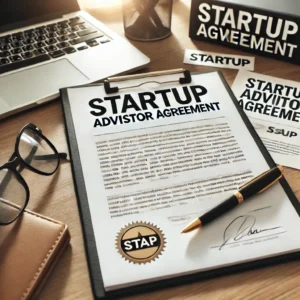Mistakes made by early-stage startups can often lead to costly litigation, loss of intellectual property, and even the dissolution of the company. In this article I will explore the five most common mistakes made by early-stage startups – and perhaps more importantly, explain how to avoid them.
A true story: each week, I engage in a few ‘legal mapping’ sessions with early-stage startup founders. During the sessions I identify potential risks, outline the steps to mitigate them and chart their legal and business needs. But I also like to have a bit of fun by making the founders think that I’m psychic.
After everyone takes a seat, I take a small piece of paper and jot something down. I then crumple it into a ball and place it at the center of the table. This action typically raises a few eyebrows, but the conversation quickly shifts back to business. As the session ends, one of the entrepreneurs usually pauses and asks: “By the way, what did you write on that piece of paper at the start of the session?” I respond with a smile, handing it to them, and observe their expressions turn somewhat pale as they read its contents.
The piece of paper contains a list of the ‘mistakes’ that the entrepreneurs have made (or are close to making) – the very ones that we just discussed during the meeting. Naturally, they are surprised at how I knew about these mistakes even before the session began.
But as much as I wish I had psychic abilities, I don’t. The reality is that after working with hundreds (perhaps thousands) of entrepreneurs, and just by knowing how many co-founders they have and what stage they’re at, I already know – with a high probability, which mistakes they’ve made or about to make. The reason being that the mistakes made by early-stage startups are just so common and are always repeating themselves.
The good news? All you have to do to avoid the mistakes made by early-stage startups is read on.
– – – – – – – – –
1. No Market Need
Background: CBS Insights conducted a study in which they wanted to discover what were the most common mistakes made by early-stage startups that lead to the failure of those startups. So they asked hundreds of founders – who had successfully raised money but later had to close their startup, to rank the reasons in order of impact. Surprisingly, the number one reason was “No market need.”
While it may seem obvious to not create something without demand, the fact that this was the main #1 reason raises a crucial question: How can intelligent, ambitious, and talented individuals invest years of their lives and tens (or hundreds) of thousands of dollars into a product or service that has “no market need”?

The Mistake: Three main reasons lead entrepreneurs to create services that no one truly needs or is willing to pay for. The first is falling in love with their idea, instead of focusing on their target audience’s pain or problem. The second is isolating themselves from others’ opinions or asking for feedback the wrong way, and the third is developing the final version of a service or product without first validating it.
The solution:
(a) focus on the problem – not the solution/idea;
(b) get as much feedback as possible (the right way) and
(c) validate your idea.
-
- It is vital that you fall in love with the problem – not the solution. You need to focus on solutions / services that solve an actual need, pain, or deep desire of your target audience. Just because YOU think it’s an amazing idea, doesn’t mean that other people will too. And even if they do, you still need to be sure that they will pay for it, and that the amount is enough to sustain your startup’s profitability. To do this, you need to make sure that your service solves a real need, one that people are willing to pay for.
- Many people feel the need to keep their idea a secret because they’re scared that someone will steal it, or of receiving criticism. In reality, it is extremely rare for someone to steal your idea because establishing a startup requires 2-3 years of extremely hard work (not just coming up with an idea) and most people are too intimidated by this. So, your idea is safe, just don’t share truly sensitive information! Additionally, the added value from getting feedback (criticism) can be invaluable. The problem is that most people go about it the wrong way.Imagine that you just had a baby and it’s the ugliest baby in the world. You know it and they know it. Nevertheless, when a friend visits, they’ll say: “wow, what a cute baby!”. Does this make them a bad friend or a liar? No. It just means that like most people, your friend doesn’t want to hurt your feelings. It’s the same with your startup. If you say: “this is my amazing startup idea. I quit my job and invested all my savings in it. What do you think?”, then obviously they’re going to give you compliments – resulting in you getting untrue support, and you thinking that it’s a great idea – even if it’s not!To get effective feedback you need to do two things: distance yourself and show that it is ok to give criticism. Here’s an example: “Hey Johnny, I wanted to get your opinion. My friend Steve wants me to join his startup. I’m not sure that their service is good enough. This is what it does…. what do you think?”. By saying this you can be sure that the feedback will be real. Additionally, always try to get feedback from people who are part of your target audience. But remember: you don’t have to follow every opinion, but keep an eye open for feedback that repeats itself.
- Validating your idea before developing the final version is crucial. I’m always saddened when a founder tells me that they spent 10 thousand Dollars developing a platform only to discover nine months (and $10,000) later that people don’t need it, or don’t need 90% of the features. So, instead of creating the final/advanced version of your service, it is crucial that you first create a basic version with only the most important features that your target audience needs (based on the feedback you received). This is called a Minimum Viable Product (MVP). Your MVP can be a landing page, a simple website, or a no-code mobile app.
By doing the above, you will substantially increase your chances of creating a service that people actually need.
2. Not Owning your own Intellectual Property
Background: Intellectual property (“IP”) is something that you create. This could be a song, painting, this article, code for an app, or your logo. Known methods of protecting your IP include patents, trademarks, copyrights, and trade secrets. Ownership of your IP is crucial for securing your competitive advantage and any chance of getting an investment or buyout.
In most countries, the default law states that whoever created the creation (i.e., the code for the app) is the owner of that code – “unless agreed otherwise” (in writing, verbally, or implied by the circumstances).

The Mistake: the most common mistakes made by early-stage startups in regard to IP is when entrepreneurs think that they own the rights to the IP, but in fact don’t. Two examples: Mike hires Jenny to create an app for him, believing that payment grants him ownership to the code. But the truth is that unless they specifically agreed to this, then by default, Jenny still owns the rights to the code. Another example: Mike and Jenny are co-founders. Jenny writes the code.
They don’t have a co-founder’s agreement, and after 3 months they get into a big fight and Jenny leaves. Because there is no agreement that states otherwise, Jenny will leave with the ownership rights to the code, and Mike will have to start from scratch.
The Solution: Have a written agreement which specifically states that you own the rights to any IP created or that the creator is transferring the rights to you. When working with a freelancer, use an IP Waiver agreement. If you’re co-founders, this is covered in the founder’s agreement. Registering patents and trademarks is also recommended, but this isn’t always affordable for early-stage startups.
3. Infringing on Others’ Intellectual Property Rights
Background: IP infringement can be unintentional but is nevertheless a significant legal issue which can lead to copyright infringement claims. Infringement can happen with trademarks, copyrights, patents, or trade secrets.
The Mistake: When entrepreneurs use materials (like documents or images or code) taken from others or the internet without the owner’s permission (sometimes not even knowing that they needed permission). Examples:
-
- After copying a Terms of Use document from a competitor’s platform entrepreneurs will often tell me: “But don’t worry, we changed a lot of the wording.” Even if you copied only 5 sentences from a 10-page document, this could still be considered copyright infringement. Additionally, even if you change a lot of sentences, many people add unique signs or text in their creations that you cannot see/remove – so they can still ‘catch’ you and sue you.
- When entrepreneurs use images/photos from Google search not knowing that they are copyrighted. Just because these images are “on the internet”, does not mean that they can be used freely. Each image has an owner and a usage license. You need to be sure that your use is within the license conditions.
A relatively new answer that I hear is: “we used Chat GPT”. Whilst this might not be considered copyright infringement, and although Chat GPT may be a great tool for getting some background, it should NOT be used to write legal documents. Chat GPT doesn’t know how to ask you the right questions, entrepreneurs don’t know what information is relevant and GPT is often inaccurate / makes things up. Lastly, anything generated by GPT won’t be owned by you (see the T&Cs of OpenAI).
The Solution: If you don’t want your startup to appear on the list of mistakes made by early-stage startups, only use materials that you own, purchased a license for or have been given a license to use (and in accordance with that license). When in doubt, either get written permission, or buy the content/license. Today you can purchase images/videos/music online for a relatively low price. You can even purchase legal documents and although these won’t fully protect you, they at least give you some protection until you can afford an attorney.
4. Not having a Founder’s Agreement
Background: The third most common reason for startup failure is “the wrong team”. Considering that establishing a startup can be very stressful, it is only reasonable that fights between founders are so common, which is why it’s so important to have a founder’s agreement.

The founder’s agreement covers issues such as founder’s roles & responsibilities, equity distribution, decision-making procedures, IP-ownership, non-competition, and many other important topics. The agreement not only adds clarity when issues arise, but the process itself forces founders to discuss the important issues before they become problematic.
The Mistake: Many startups, especially those launched by friends/colleagues, or family members, overlook the need for a founder’s agreement. Not having an agreement leaves the founders in unknown waters when disagreements arise – including issues such as IP ownership. At best, these disagreements negatively affect the progress of the startup. At worst, they lead to prolonged legal proceedings, loss of potential investments, and shutting down the startup.
The Solution: Regardless of the relationship between the co-founders, always sign a founder’s agreement early on, and unlike other agreements, use an attorney for this one.
5. Setting Up the Company Too Early or Too Late
Background: A company is a separate legal entity. Meaning that the company is not you (the founders) and you are not the company. This means that the company can enter into agreements, end them, sue, and get sued, and do (almost) anything else that you can do. Just as if it was a living person. Knowing when to incorporate can have a substantial effect on expenses, taxes and legal issues.
The Mistake: Incorporating too early can result in unnecessary costs, such as the filing of yearly reports, taxes, and attorney/accountant fees. Example: A group of friends develops a mobile app and decides to form a corporation immediately. They incur legal and administrative costs to do so, however, after a few months, they realize the concept won’t succeed. Now, they need to dissolve the company, incurring further expenses. On the other hand, if you incorporate too late it may result in additional taxes (when transferring your Intellectual Property from the founders to the company – as this is considered as if the company gained something of value).
Also, if something goes wrong with the business and someone decides to sue you, then you – personally – will be the one being sued. But, if you had a company, the company would be sued, and you would be protected (assuming you didn’t do anything illegal). Lastly, not incorporating may affect your chances of getting an investment, because investors prefer giving the money to a company, and not to a person.
The Solution: Try and find the right balance and consult with an experienced attorney as to when is the right time. If you’re at the idea stage, and still researching the market, you don’t need to incorporate. If you’re creating valuable IP, you’re about to launch your MVP, or you’ve started fundraising (which should be done after you’ve tested your MVP), then it would be wise to incorporate.
– – – – – – – – – – –
It’s easy to avoid these mistakes if you have a good mentor. In my 1-hour Legal Mapping sessions, I analyze your startups’ needs and discuss the mistakes made by early-stage startups so that you can avoid them. Do you want to avoid these mistakes? Set up a Legal Mapping session now!.



